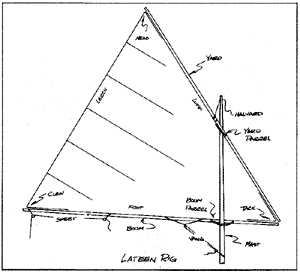|
The Lateen Rig
Finding a Suitable Use
for a Simple Rig
by Chris Wentz
from Small Boat Journal #40 Jan. 1985
drawings by the author
Because the SunFish and its brethren
are surely the most numerous type of
boat on the water, the lateen rig may be
the most widely used rig in the U.S. (No,
I don't consider Windsurfers to be
boats.) Many builders of series-produced small craft choose this rig for their
boats, and a fewyears back the American
Canoe Association selected the lateen
rig for their Cruising Class.
The reason for this widespread popularity escapes me. The ancient lateen rig
was completely passed over by Western
seafarers hundreds of years ago, not
because it doesn't sail well — it sails
very well indeed — but because the rig
has vices which render it unsuitable for
general use.

click to enlarge
The problem is twofold: Lateen rigs
generate lots of what I call "jibing inertia." The lateen rig has not one, but two
very long spars to swing over during a
jibe. This moving mass is critical in a
small boat, which may not have lots of
transverse stability. Also, lateen rigs rarely have a boom vang to limit twist in the
sail. A twisted sail creates a rolling force
which, combined with a mass of swinging spars, makes jibing, a fundamental
sailing maneuver, an invitation to capsize.
The lateen rig is most frequently seen
on and is ideally suited to "board boats"
such as the Sunfish. They're simple and
sporty and have introduced thousands
into the sport of sailing. Board boats
capsize easily — which helps to keep
neophytes from getting into too much
trouble — but they are also easily righted and sailed away. For a lateen rigger,
self-rescuing ability is definitely a good
thing. In a dinghy or canoe, however, a
capsize puts you out of action until you
drift or get towed ashore.

You certainty can help matters by putting a vang on a lateen rigger, but it's
best not to do it exactly as you would on
a Bermudian rig. Usually a lateen boom
has a small diameter, which will not
withstand a point load. And because the
boom is so long, it may drag in the water
at times, causing it to break at the vang
attachment point. One solution is to attach the vang to the boom via a "span" to
distribute the load over two attachment
points.

An adjustable outhaul would be very
useful, but I've never seen one on a
lateen rigger. It may be because the
ready-made fittings available from many
sparmakers have no provision for one. It
would be easy to make a wooden end
cap with a dumb sheave to fit the
aluminum spars.
Most lateen sails are attached to the
yard and boom with plastic clips that
look like they were borrowed from a
shower curtain. Eventually these get old
and break. Rather than sail around with
missing clips, reeve a spiral lacing line
round the boom (or yard). It's far more
durable, a lot easier to find, and cheaper.
This is one of the few places in a sailboat's rig where you can use nylon line,
which can be bought in any hardware
store. At least one manufacturer attaches
its sail with sleeves. This approach is as
durable as the sail itself and is no doubt
superior aerodynamically.

Many board boats are rigged by the
manufacturer so that the sheet trims to a
point along the boat's centerline. This
should never be done on any boat with a
single sail, because as you pull the
boom down to set the leech of the sail,
you also pull the sail in too close to the
centerline, stalling forward motion. If
your boat has a bridle with a loop in the
center to attach the sheet to, ignore the
loop and tie the sheet onto the bridle
with a loose bowline so the sheet can
slide from one side of the boat to the
other.

Lateen sails are not removed from
their spars when the boat is idle. Even
so, the sail should not be left out in the
elements for storage. Sunlight deteriorates synthetic sailcloth and fades colors. If you wish to keep your sail bent on
your lateen rig, either take the spars
inside or make up a simple sail cover.
Mother Nature's own cotton duck is best
for this because it breathes, letting the
sail dry. The sail will look better and last
longer for it. A light color cover will
keep things under it cooler and help prevent mildew.
|

